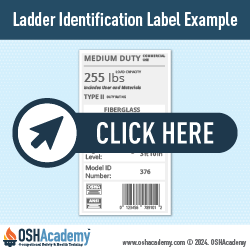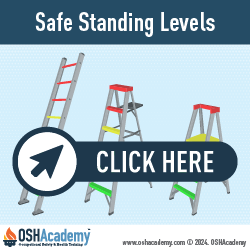General Requirements - Ladders
Falls from portable ladders are one of the leading causes of occupational fatalities and injuries. Before using a ladder, read and follow all the labels and markings on the ladder.
Below are some ladder do's and don'ts:
- Do keep ladders in a safe condition and store ladders appropriately.
- Do keep the area around the top and bottom of a ladder clear.
- Do replace all frayed or badly worn ropes.
- Do make sure rungs, cleats,and steps are level and uniformly spaced.
- Do use ladders only for their designated purpose.
- Don't tie ladders together to make longer sections.
- Don't use single rail ladders.
- Don't load ladders beyond the maximum load for which they were built.
- Don't use damaged or defective ladders.
- Don't climb too high on the ladder.
- Don't hand carry loads or equipment while on a ladder.
- Don't reach to the point where you lose your balance.
- Don't stand or work on the top cap or the step below the top cap of a stepladder.
- Don't stand or work on the top 3 rungs of an extension ladder.
- Don't place ladders on boxes, barrels, pick-up truck beds, scaffolds, or equipment.
- Don't use portable ladders in a horizontal position as a plank, platform, or scaffold etc.
- Don't splice together short ladders to make longer ladders.
- Don't use ladders in high winds.
- Don't use extension ladders without maintaining minimum overlap.
- Don't use a ladder that does not meet the required duty rating.
- Don't use a metal ladder when working on or near electrical circuits.
Knowledge Check Choose the best answer for the question.
2-1. Don't stand or work on the _____ of an extension ladder.
You forgot to answer the question!


